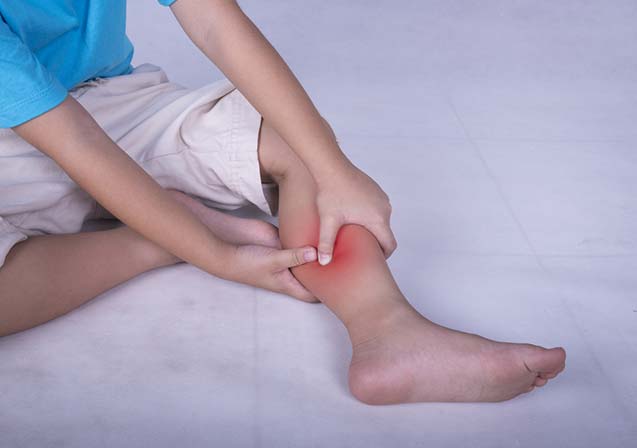GROWING PAINS MEANING
Growing pains is the pain that growing children experience in their legs. Growing pains are usually experienced at night and may be related to a lowered pain threshold of the child.
Ayurveda does not recognize the concept of growing pains. Pain although is a symptom that is covered under vatavyadhi.
According to Ayurveda, pain is attributed to Vatadosha, thus any kind of Aghat or shock will sensitize the pain Vata dosha. Ayurveda divides pain into categories depending upon the element (dosha: Vata, Pitta, Kapha) that caused them.
We have pain due to dryness and excessive air within the system, which is attributed to Vata dosha. This dry pain may appear extreme, come and go, travel throughout the body, feel like pins and needles, prickling pain or numbness.
Vata – Pitta Pain : Presents with burning, is intense in nature and localized.The intensity increases until peak is achieved around midday or midnight.
Vata-Kapha pain: it is a dull and localized type of pain. Pain increases in intensity gradually over 6 hours to upto 25 hours and last for days. Pain is highly troubling in late evening or early morning.

CAUSES OF GROWING PAINS
The exact cause of growing pains is not known. It is assumed to have a psychological reasons and it is well accepted that the growth of the child is not a reason even though the pains are called as growing pains. It is likely that over-activity of children during the day may cause these pains at night.
In my 16 years reach experience in practices, I observed one of the root cause of growing pain in children at the time of growth of children this muscle and bones are also growing at the time vata, dosh and asthi dhatu imbalance. Children suffering growing pain.
SYMPTOMS OF GROWING PAINS
Some common symptoms of growing pains include1:
• Aching & throbbing feeling in the legs
• Pain in front of the thighs, calves and behind the knees
• Pain in both legs
• Pain usually at night
• Abdominal pain & headaches sometimes
• Pain in the joints
• Pain after an injury
• Swelling, redness and tenderness
GROWING PAINS AYURVEDIC TREATMENT
Ayurveda recommends a general line of treatment for Vata dosha, Asthi and majja dhatu imbalance.
Internal treatments
- Vata dosh chikitsa
- Asthimajjavah chikitsa
- Manas chikitsa
- Height management treatments
- Immuno therapy
Panchkarma
- Basti
- Snehan
- Swedan
- Abhyang
- Udavartan
- Lepan
DIET RECOMMENDATIONS (AAHAR)
Vata balancing diet
- Grains – Rice, wheat, barley, corn, millet, buckwheat, rye, oats
- Vegetables – Peas, green leafy vegetables, broccoli, cauliflower, celery,
- Fruits – apples, pears, pomegranates, cranberries, dry fruits after soaking overnight
- Sweeteners – jaggery, honey, maple syrup
- Oils & Ghee – Sesame oil, Cow ghee
Pitta balancing diet
- Vegetables – asparagus, lettuce, broccoli, cucumber, raita, mung dhal, summer squashes, courgettes, cilantro, coconut, cucumber, lime and green salads.
- Fruits – Peaches, figs, berries, raisins, pineapples
- Grains – wheat, basmati rice, oats, barley, corn, millet and rye
- Herb teas – peppermint, spearmint, rose, coriander or liquorice
- Ghee
Kapha balancing diet
- Vegetables – Asparagus, Broccoli, Brussels sprouts, Bean sprouts, Cabbage Carrots Cauliflower, Lettuce Peas Peppers Potatoes (roast) Radish/Spinach
- Fruits – Apples Apricots, Berries, Cherries Cranberries, Grapefruit, Papaya, Peaches, Pears, pomegranates, raisins, Watermelon
- Grains – barley, buckwheat, quinoa, amaranth, corn, millet and rye
- Herbs – Hot lime water with ginger, barley tea
LIFESTYLE CHANGES (VIHAR)
Yoga asanas, daily Ayurvedic body therapies and massage with special herbs, oils to rub into afflicted areas, lifestyle support, specific exercises, meditation, visualization (consciously using your natural creative imagination to make positive changes in your life and health), breathing, mantra repetitions, and prayers are recommended.
Types of Pranayama: Bhastrika pranayama, Suryabhedana pranayama, Anuloma-viloma pranayama
Yoga Asanas: Bhujangasana, Uttanapadasana, Sarvangasana (Yogasanas are to be practiced under supervision)
Bhastrika pranayama

Suryabhedana pranayama

Uttanapadasana

Sarvangasana


